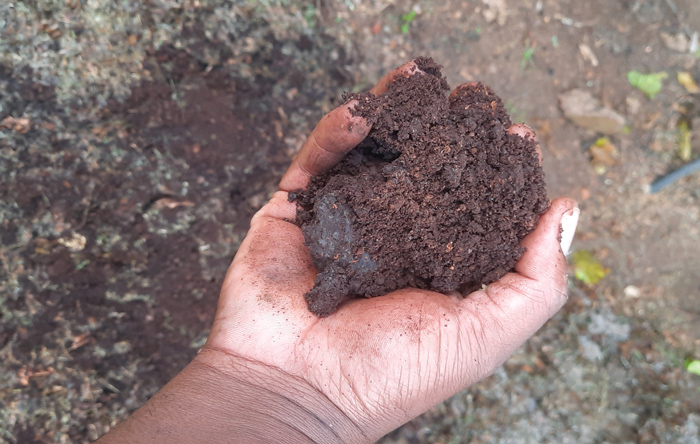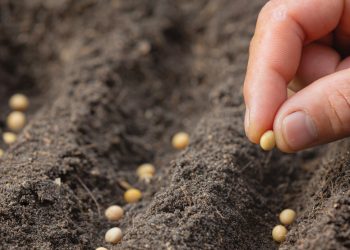
Composting is the natural process of recycling organic matter, such as leaves and food scraps, into a valuable fertiliser that can enrich soil and provide nutrients to plants. Anything that grows, eventually decomposes. Composting simply speeds up the process by providing an ideal environment for bacteria, fungi and other decomposing organisms to do their work. The resulting decomposed matter, which often ends up looking like fertile garden soil, is called compost. Fondly referred to by producers as ‘black gold’, compost is rich in nutrients and can be used for gardening, horticulture and agriculture.
Composting process
Microorganisms are vital to the composting process and are found everywhere in the environment. The key to effective composting is to create an ideal environment for the microorganisms to thrive. Composting creates the ideal conditions for the natural decay or rotting processes that occur in nature and requires the following:
- Organic waste – leaves, grass, kitchen waste (fruits, vegetables) or woody materials.
- Soil – a source of microorganisms.
- Water.
- Air as a source of oxygen.
During composting, microorganisms from the soil eat the organic waste and break it down into its simplest compounds. This produces a fibre-rich, carbon-containing compost with inorganic nutrients such as nitrogen, phosphorus and potassium.
The microorganisms break the material down through aerobic respiration and require oxygen that they get from the air, which is introduced when you turn the material in the compost pile. Microorganisms also require water to live and multiply. Through the respiration process, the microorganisms give off carbon dioxide and heat.
Temperatures within compost piles can rise as high as 38°C to 66°C. If the compost pile is actively managed by turning and watering it regularly, the process of decomposing into finished compost can happen in as little as two to three weeks.
Given the above requirements, the compost conditions must also be balanced for efficient decomposition. There must be a proper mix of carbon to nitrogen (C:N), with a ratio of about 30:1.
The 30:1 C/N-ratio
Of the many elements required for microbial decomposition, carbon and nitrogen are the most important. Carbon provides both the energy source and the basic building blocks, making up about 50% of the mass of microbial cells. Nitrogen is a crucial component of the proteins, nucleic acids, amino acids, enzymes and co-enzymes necessary for cell growth and function.
The ideal C/N-ratio for composting is generally considered to be about 30:1 or 30 parts carbon for each part nitrogen by weight. At lower ratios, nitrogen will be supplied in excess and will be lost as ammonia gas, causing an undesirable smell. Higher ratios mean that there is not sufficient nitrogen for optimal growth of the microbial populations, so the compost will remain relatively cool and degradation will proceed at a slower rate.
It’s not a perfect science on the compost pile but you can achieve a good balanced C/N-ratio by ensuring that your compost pile is one third of the greens (nitrogen-containing matter) and two thirds of the browns (dry-carbon material) – see Table 1. In the summer, when most things are green and there is a low source of carbon, you can cut your grass and leave it to dry and use it as your carbon source.
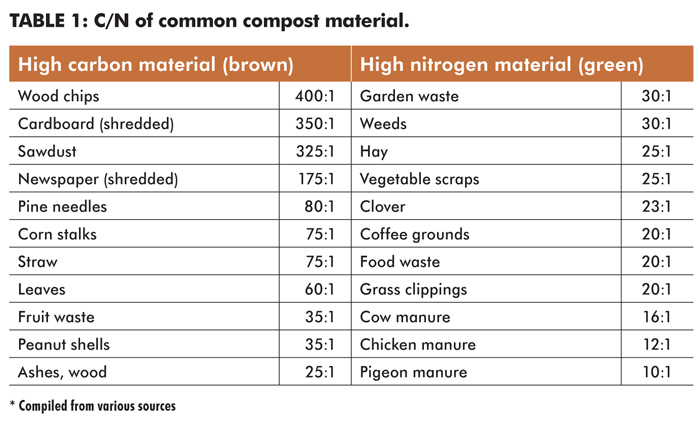 Benefits of composting
Benefits of composting
BALANCES SOIL DENSITY
Compost helps plant growth by balancing the soil density. In soils that are compacted or structureless, compost helps to loosen the soil, whereas in soil that is too loose it helps to clump it together. This balancing allows plants to develop healthier roots into the soil, which is contributing to healthier growth.
ENHANCES THE NUTRIENT CONTENT OF THE SOIL
It improves soil’s ability to hold nutrients and delivers much-needed nutrients. Once turned into humus, compost improves nutrient retention by increasing the soil’s cation exchange capacity (CEC) and then it delivers needed food for the plants in the form of nitrogen, phosphorus and potassium.
REDUCES WASTE
Waste reduction is another benefit of composting since compost is generally made from waste such as food scraps and organic by-products that are diverted from landfill flows. This reduces the amount of waste going to landfills and it upcycles these materials into a productive, environmentally beneficial product.
COMBATS CLIMATE CHANGE
Compost is also a potent tool in combatting climate change. It cuts down on greenhouse gases from landfills entering the atmosphere and makes ecosystems more resilient to rising temperatures.
IMPROVES SOIL HEALTH
By adding nutrients and soil biota, compost improves the biological, chemical and structural health of soils. This further contributes to healthy plants and reduces or eliminates the need for chemical fertilisers.
CONSERVES WATER
It can also conserve water due to its ability to retain and efficiently transfer water. This both helps the environment and allows the soil to maintain its moisture levels, which reduces the need for regular watering.
Hot composting process
DAY ONE
- Construct the compost pile by mixing together ingredients and laying them in alternating thin layers of ‘greens’ and ‘browns’ until the pile is 1 m wide and 1,5 m tall (Photo 1).
- Wet the compost heap down very well, so water is dripping out of the bottom and it is saturated.
- Cover your compost pile with a canvas or plastics, with a few holes to allow for gaseous exchange (Photo 2). The cover prevents the compost from drying out too quickly and helps to preserve the heat generated.
- Let the compost pile sit for four days. The temperature inside the compost pile should rise to about 55°C to 65°C if the mixture is done correctly.
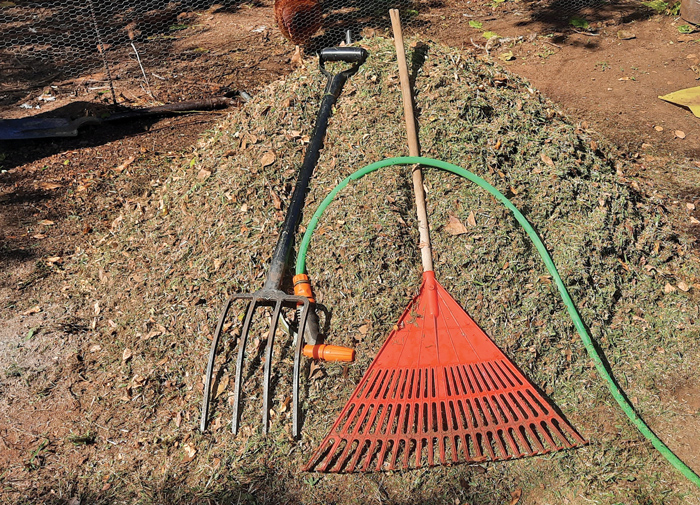
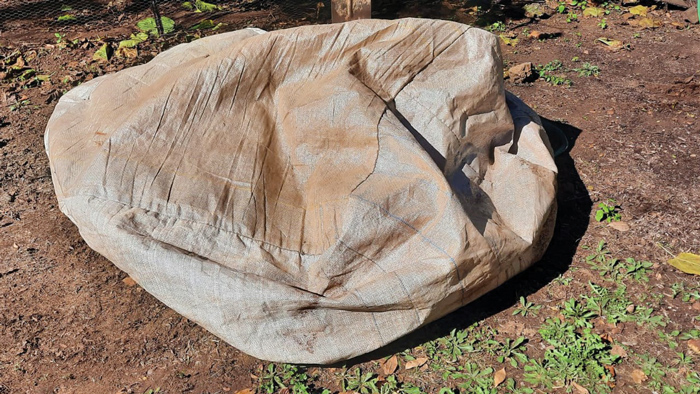
DAY FIVE ONWARDS
- Turn the compost pile inside out. Do this by moving the outside of the pile to a spot next to it and keep moving material from the outside to the new pile. When the turning is completed, all the material that was inside the pile will be outside and vice versa.
- Keep the compost moist at such a level that when you squeeze a handful of the composting material, only one or two drops come out.
- From day five onwards until day 18, you need to turn the compost every second day in the same manner as described above and continue to monitor the moisture content as well.
- If during turning on day seven you realise that the compost is not hot enough and there is too much brown material, you may need to add a source of nitrogen, such as coffee grounds (Photo 3). Coffee grounds are excellent, as they are already broken down and would not delay the compost, as compared to adding fresh grass clippings or leaves.
- On day 18 your compost should be ready for use. This should be a warm dark brown material that does not have any bad smell (Photo 4). You can apply the compost to your garden or flower beds at this stage.
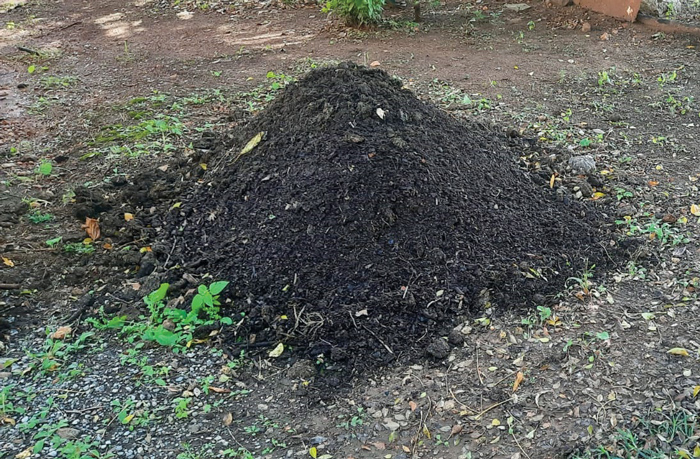
If you leave the compost in a pile for use later, organisms such as earthworms will move into the compost, which is indicative of a good nutrient status in the compost.
Summary
- If the compost gets too wet, just remove the cover to allow excess water to evaporate.
- Should the compost become smelly, add more brown material.
- Add some coffee ground, if the compost does not get hot enough.
- If you make errors, it will not spoil, it will just take longer to be ready.
- Do not be scared to try – it costs you nothing if you fail, since you are using garden waste.
- Learn as you go.



